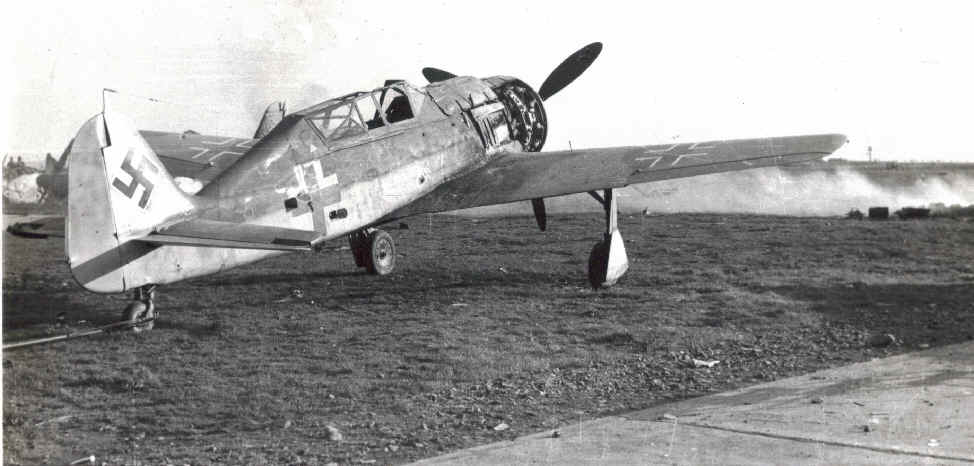
Image du Jours -- World War II
About this Fw-190 -- WWII #15 of 23.

(Image from Stockum-Cashion Collection)
An Unusual Aircraft
And now here is another view of the Fw-190S (nee Fw-190A-8/U1) with the two seats.
This aircraft is sitting between two, twin-engine bombers which will be seen later. Obvious is the smoke from some burning things in front of the aircraft. Whatever is burning, it isn't seen in other photos.
There is a tail-wheel guide bar attached to the Fw-190.
The aircraft has no guns showing.
Note that the general work on this modification is pretty crudely done. I will assume that it was a factory mod though it could have been a field mod without any training purposes in mind.
Also, remember that the canopy on the tandem Me-109 had a raised back seat with a small windscreen so that pilot could have some forward visibility, this Fw-190 however, did it differently and I would have thought it was much more difficult to see out.
The canopy on the aft, right side has four, flat sections on the side canopy which goes to a point. This would permit the rear pilot to lean his head to the side to see forward or down a little -- but just a little.
I would assume that for the Stuka pilots to have survived much of the war, they were pretty good pilots and this Fw-190 modification was not to teach them to fly but rather to give them the feel of a fighter rather than the big dive-bomber they had been flying -- and the Stuka was really a big aircraft.
On this Fw-190, the canopy on the front has the right side fixed to the windscreen, and the top and left side probably hinged at the top edge of the fixed side.
I can't see how the rear pilot got in. ("With difficulty?")
As a model designer and flier, one of the most serious things I have to contend with (besides the ground) is the CG location; consequently, I have become fascinated by the CG and proportions on full-sized aircraft.
I look at some of the antique aeroplanes and see where the wing leading edge was interrupted so the engine could be set back closer to the CG and the uncovered spruce frame work behind the CG had been kept light.
So this aircraft mod would have affected the original CG -- most mods do. This airplane had about 200 lbs. (including pilot) added six feet behind the original CG so something had to be moved to keep the design CG where it belonged. Add in front of the CG (always Plan B) or remove weight in the back or moved weight in the back.
What could be moved in the back?
What was back there?
Well, the big auxiliary fuel tank was removed to make room for the second crewman, but the radio and the radio transformer, which are rather heavy, needed to be somewhere, and there were a bunch of oxygen bottles back there.
So all told, if they pulled the armor, fuel tank, and moved the radio and transformer forward, the proper CG could have been easily managed.
The two inspection ports on the right side are not often seen in photos. (Why are most aircraft views limited to the left side, and why are so many aircraft entered from the left?)
The rearward, upper port permitted access to an adjustable coupling to the elevator. The elevator was coupled to a bunch of inter-related things in the back and all this interplay had to be accurately adjusted. If an overall elevator adjustment was needed, it was done through this port.
The other port is aligned with six spherical oxygen bottles, three on each side and they were coupled together. There was a "T" valve at this port. This was most likely where these bottles were filled and the pressure checked.
(On the negative that produced this print, the white sky above the aircraft had large pieces of emulsion torn free, leaving on a print, black areas. These are not in the images because I digitally removed them and replaced them with sky. This is the only kind of "retouching" these images have received.)
There is another short Fw-190 story. "Fw" stands for "Focke-Wulf", of course, and during the air wars in Europe there were many non-combatants in the U.S. doing what they could to cheer and inspire the members of the armed forces who were in harm's way. One method was by producing and circulating inspiring posters.
At the Pre-Mission Briefing Room of a major US air base in England, a poster fresh from the U.S., was put up by the door. It showed a confident and cheerful bomber pilot singing, "Whose afraid of the new Focke-Wulf?" And there were other Little Pigs song references.
Someone locally posted a big white sheet under the picture and wrote at the top: "SIGN HERE."
In very short order, every bomber pilot, co-pilot, etc., had put their names on that list...including the squadron commanders and several higher ranking officers.
Aircrews accepted the statistics of being hit by random flak, but being attacked by a particular individual in a machine that could blow the bomber out of the sky in a rain of fire and debris...and do this with but one shot into a wing spar...this wasn't random but controlled by intellect. They accepted flak; they feared the fighters.
Ken Cashion